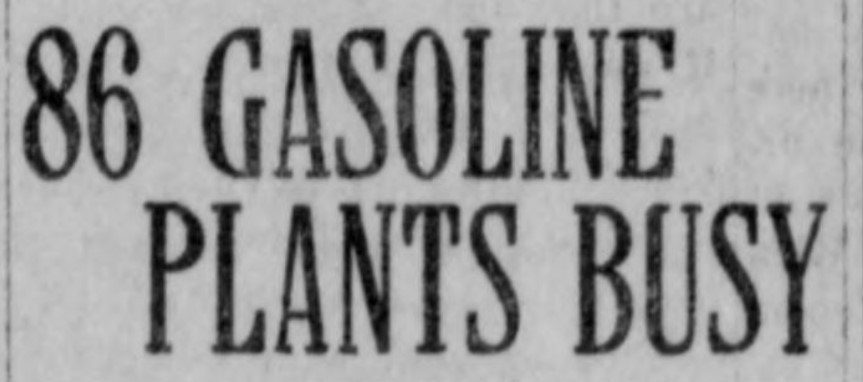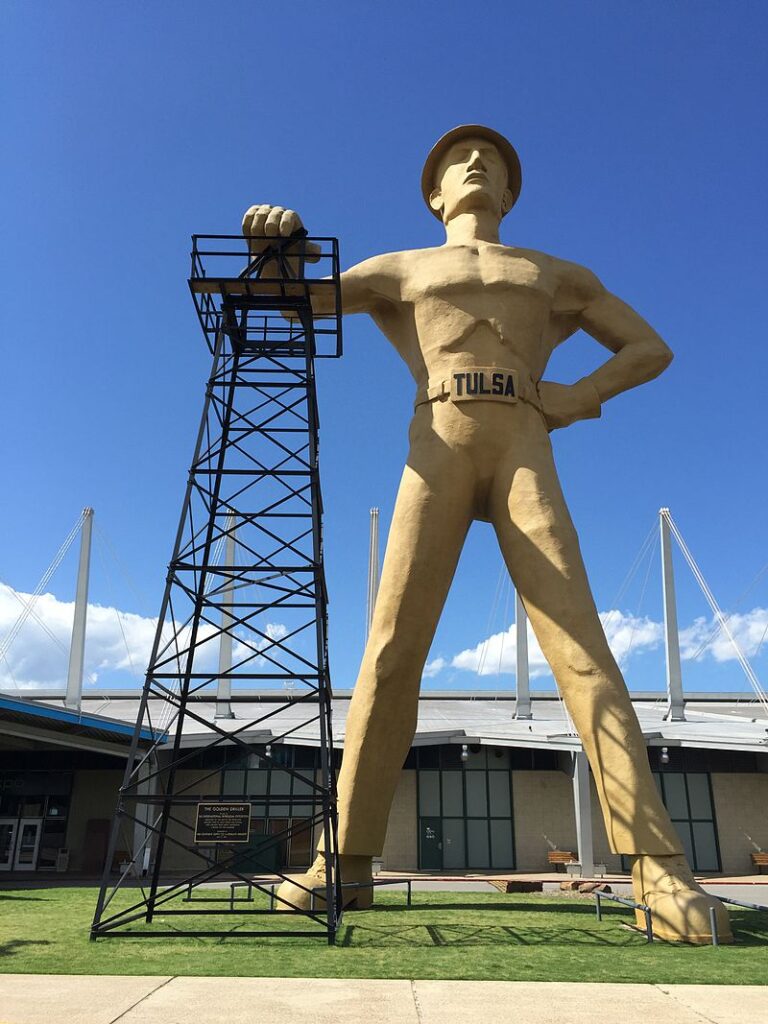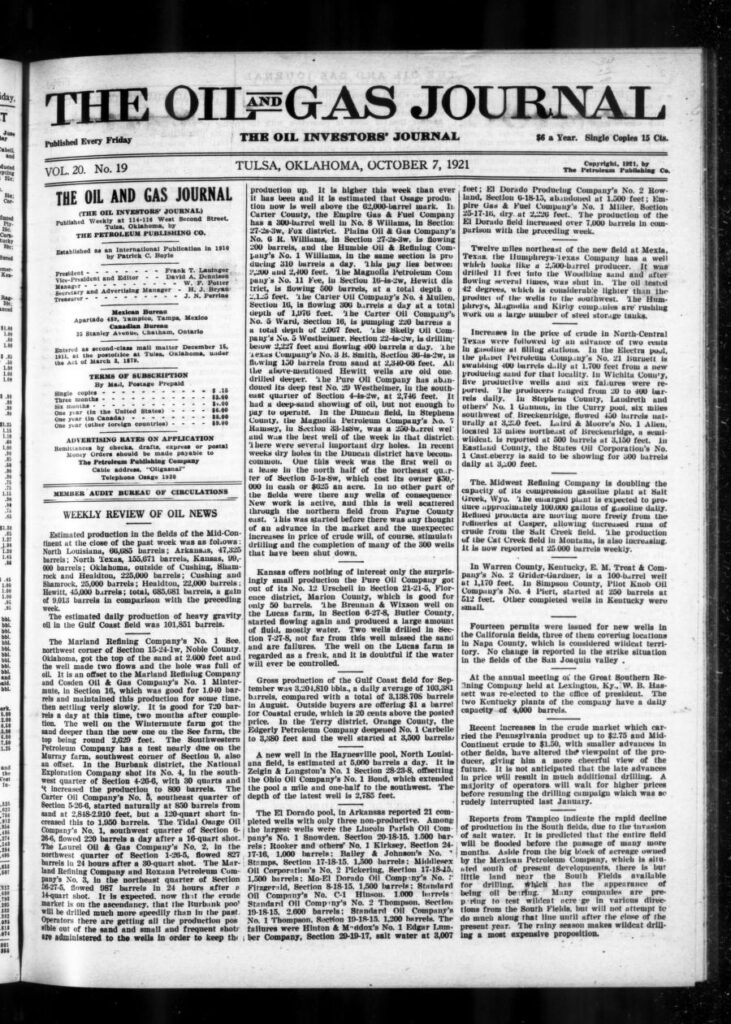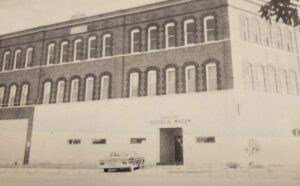Rachel Whitney, Curator, Sapulpa Historical Museum
“The history of Oklahoma Natural Gas spans a century of petroleum history and illustrates the industrial advances that brought amenities such as public utilities, specifically heat and light, to urban communities throughout the Sooner State. In 1905 two entrepreneurs, Dennis T. Flynn, a former territorial representative to Congress, and his law partner, Charles B. Ames, devised a plan to tap the wealth of natural gas available in the oil fields of north-central Oklahoma. They joined forces with H. M. Byllesby of Chicago, for whom they were attorneys. All three were also involved with Oklahoma Gas and Electric Company (OG&E). They intended to create a new venture to bring gas to Oklahoma City from the Cleveland Field. Flynn was the president and Ames the assistant secretary, and other oilmen served as directors.
“Oklahoma Natural Gas Company incorporated on October 9, 1906. After Byllesby backed out, the two brought in experienced Pennsylvania pipeliner and former Standard Oil Company executive Glenn T. Braden and Pittsburg oilman Theodore N. Barnsdall. Their Osage and Oklahoma Gas Company had been formed in 1905 and was supplying Tulsa’s natural gas from the Osage Field. The reorganized ONG spent the spring and fall of 1907 building a gas pipeline from Braden’s Osage leases to Sapulpa and to the capital city. Braden eventually succeeded Flynn as president.”
This week in Sapulpa history, Sapulpa and Creek County was credited to having the “largest number of [natural gas] plants for any county in the state.”
On September 28, 1921, a large headline indicated Sapulpa was at the top: “List of Natural Plants Shows Big Growth of Industry in Creek County.”

An estimate earlier that year stated that the area was still growing. “A list of the natural gasoline plants in Creek County, recently compiled, shows large increases in this industry in the past few years. Although at first estimated that only 60 plants were in the county, the list compiled shows 86 natural gasoline plants.”

For this, the Chamber of Commerce sent the list of plants to be published in the Oil and Gas Journal.
The petroleum industry was also the county’s largest employer outside of the railroad positions.
“Oil ushered Oklahoma into the twentieth century and gave it an economic base that for decades allowed continued development. The state’s petroleum deposits lie within a vast reserve called the Mid-Continent Region, an area that also encompasses Kansas, Texas, Arkansas, Louisiana, and New Mexico. For twenty-two years between 1900 and 1935 Oklahoma ranked first among the Mid-Continent states in oil production and for nine additional years ranked second.”
Mid-Continent Petroleum had been in Sapulpa for a short while, possibly around decade, between 1930 and early-1940s, before moving to Ponca City. Sapulpa, Tulsa, Bartlesville, Ponca City, Cushing, and many others had claims to be the oil capital. Tulsa took the name Oil Capital, whereas Sapulpa dubbed itself Oil City.
By the 1950s, Mid-Continent Supply Company out in Fort Worth featured a Golden Driller. It was built for the International Petroleum Exposition. However, in just a short while, Tulsa received a donation of a new version of the Golden Driller.
Dallas Meade Constructors in 1966, a Sapulpa native, John Stephens was the superintendent. Stephens served in the Navy before joining the “wildcatters” on oil fields. With his background in the oil industry, Stephens found himself in a perfect position.
Not only was he the supervisor, he was a model for the Tulsa Golden Driller statue. The iconic statue stands 76 feet tall, as the sixth-tallest statue in the United States. The statue’s belt once read “Mid-Continent” but that has been changed to say “Tulsa” since 1979. That same year, it was considered a state monument.

“An inscription at the base of the statue reads: “The Golden Driller, a symbol of the International Petroleum Exposition. Dedicated to the men of the petroleum industry who by their vision and daring have created from God’s abundance a better life for mankind.”
In 2006, the statue was listed among the Top Ten “Quirkiest Destinations” in the United States.


Last year, Tulsa featured a new holiday, in honor of Stephens, dedicating January 30th as Stephens’ Day in Tulsa County.
As the Golden Driller is a part of Tulsa’s history, the man behind the statue is a part of Sapulpa’s history. This week in Sapulpa history, sadly, John Franklin Stephens, Jr. passed away at the age of 88.
(Sapulpa Herald, September 28, 1921; Oklahoma Historical Society; Fox23, January 31, 2023; KRMG, September 25, 2024; NewsOn6, September 26, 2024; RoadsideAmerica; Wikipedia)










